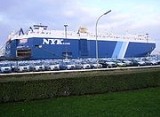
Nippon Yusen
Encyclopedia
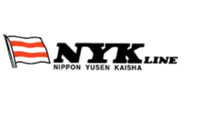
Japan
Japan is an island nation in East Asia. Located in the Pacific Ocean, it lies to the east of the Sea of Japan, China, North Korea, South Korea and Russia, stretching from the Sea of Okhotsk in the north to the East China Sea and Taiwan in the south...
-based (Japan Mail Shipping Line) or NYK Line, is one of the largest shipping
Shipping
Shipping has multiple meanings. It can be a physical process of transporting commodities and merchandise goods and cargo, by land, air, and sea. It also can describe the movement of objects by ship.Land or "ground" shipping can be by train or by truck...
companies in the world. It is a core Mitsubishi
Mitsubishi
The Mitsubishi Group , Mitsubishi Group of Companies, or Mitsubishi Companies is a Japanese multinational conglomerate company that consists of a range of autonomous businesses which share the Mitsubishi brand, trademark and legacy...
company. The company has its headquarters in Chiyoda, Tokyo
Chiyoda, Tokyo
is one of the 23 special wards in central Tokyo, Japan. In English, it is called Chiyoda ward. As of October 2007, the ward has an estimated population of 45,543 and a population density of 3,912 people per km², making it by far the least populated of the special wards...
.
1870-1900
The company traces its history back to the Tsukumo Shokai Shipping company founded by the TosaTosa Domain
The was a feudal domain in Tosa Province of Japan during the Edo period. Its official name is . Some from the domain played important roles in events in the late Tokugawa shogunate...
clan in 1870. In 1875, as the re-named Mitsubishi Shokai, the company inaugurated Japan's first passenger liner service, with a route from Yokohama
Yokohama
is the capital city of Kanagawa Prefecture and the second largest city in Japan by population after Tokyo and most populous municipality of Japan. It lies on Tokyo Bay, south of Tokyo, in the Kantō region of the main island of Honshu...
to Shanghai
Shanghai
Shanghai is the largest city by population in China and the largest city proper in the world. It is one of the four province-level municipalities in the People's Republic of China, with a total population of over 23 million as of 2010...
; and in that same year, the company name was changed to Mitsubishi Mail Steamship Company. In 1885, a merger with Kyodo Unyu Kaisha (founded 1882) led to the adoption of the company's present name.
The merged company had a fleet of 58 steamships and expanded its operations rapidly, first to other ports of the East and then worldwide, with a liner service to London
London
London is the capital city of :England and the :United Kingdom, the largest metropolitan area in the United Kingdom, and the largest urban zone in the European Union by most measures. Located on the River Thames, London has been a major settlement for two millennia, its history going back to its...
being inaugurated in 1899.
1900-1950
The majority of Japanese merchant ships, tankers and liners sailed under the NYK banner during this period. Regular services linked KobeKobe
, pronounced , is the fifth-largest city in Japan and is the capital city of Hyōgo Prefecture on the southern side of the main island of Honshū, approximately west of Osaka...
and Yokohama
Yokohama
is the capital city of Kanagawa Prefecture and the second largest city in Japan by population after Tokyo and most populous municipality of Japan. It lies on Tokyo Bay, south of Tokyo, in the Kantō region of the main island of Honshu...
with South America
South America
South America is a continent situated in the Western Hemisphere, mostly in the Southern Hemisphere, with a relatively small portion in the Northern Hemisphere. The continent is also considered a subcontinent of the Americas. It is bordered on the west by the Pacific Ocean and on the north and east...
, Batavia
Jakarta
Jakarta is the capital and largest city of Indonesia. Officially known as the Special Capital Territory of Jakarta, it is located on the northwest coast of Java, has an area of , and a population of 9,580,000. Jakarta is the country's economic, cultural and political centre...
, Melbourne
Melbourne
Melbourne is the capital and most populous city in the state of Victoria, and the second most populous city in Australia. The Melbourne City Centre is the hub of the greater metropolitan area and the Census statistical division—of which "Melbourne" is the common name. As of June 2009, the greater...
, Cape Town
Cape Town
Cape Town is the second-most populous city in South Africa, and the provincial capital and primate city of the Western Cape. As the seat of the National Parliament, it is also the legislative capital of the country. It forms part of the City of Cape Town metropolitan municipality...
; and frequent cruises to San Francisco and Seattle. Other routes connected local Chinese cabotage
Cabotage
Cabotage is the transport of goods or passengers between two points in the same country by a vessel or an aircraft registered in another country. Originally starting with shipping, cabotage now also covers aviation, railways and road transport...
vessels on the Chinese coasts and upper Yangtze
Yangtze River
The Yangtze, Yangzi or Cháng Jiāng is the longest river in Asia, and the third-longest in the world. It flows for from the glaciers on the Tibetan Plateau in Qinghai eastward across southwest, central and eastern China before emptying into the East China Sea at Shanghai. It is also one of the...
.
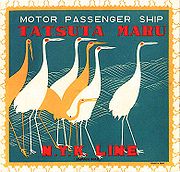
Vancouver
Vancouver is a coastal seaport city on the mainland of British Columbia, Canada. It is the hub of Greater Vancouver, which, with over 2.3 million residents, is the third most populous metropolitan area in the country,...
(Canada) or Seattle (USA). Another way was to stop in Hawaii, and continue to San Francisco and the Panama Canal
Panama Canal
The Panama Canal is a ship canal in Panama that joins the Atlantic Ocean and the Pacific Ocean and is a key conduit for international maritime trade. Built from 1904 to 1914, the canal has seen annual traffic rise from about 1,000 ships early on to 14,702 vessels measuring a total of 309.6...
. The next commercial routes were south from Japan, across the East China Sea
East China Sea
The East China Sea is a marginal sea east of China. It is a part of the Pacific Ocean and covers an area of 1,249,000 km² or 750,000 square miles.-Geography:...
. These went to South East Asia, the China coasts, and towards India and the Indian Ocean, to Europe or Batavia
Jakarta
Jakarta is the capital and largest city of Indonesia. Officially known as the Special Capital Territory of Jakarta, it is located on the northwest coast of Java, has an area of , and a population of 9,580,000. Jakarta is the country's economic, cultural and political centre...
(Dutch Indies), or Australia
Australia
Australia , officially the Commonwealth of Australia, is a country in the Southern Hemisphere comprising the mainland of the Australian continent, the island of Tasmania, and numerous smaller islands in the Indian and Pacific Oceans. It is the world's sixth-largest country by total area...
and New Zealand
New Zealand
New Zealand is an island country in the south-western Pacific Ocean comprising two main landmasses and numerous smaller islands. The country is situated some east of Australia across the Tasman Sea, and roughly south of the Pacific island nations of New Caledonia, Fiji, and Tonga...
. The fastest services took ten days from Yokohama to Seattle, and one month to Europe.
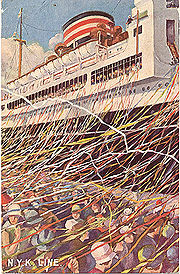
South Pacific Mandate
The was the Japanese League of Nations mandate consisting of several groups of islands in the Pacific Ocean which came under the administration of Japan after the defeat of the German Empire in World War I.-Early history:Under the terms of the Anglo-Japanese Alliance, after the start of World...
and Formosa
Taiwan
Taiwan , also known, especially in the past, as Formosa , is the largest island of the same-named island group of East Asia in the western Pacific Ocean and located off the southeastern coast of mainland China. The island forms over 99% of the current territory of the Republic of China following...
, cotton, salt and minerals represented other important parts of these transport transactions. The current funnel livery was introduced in 1929.
The company also ran services connecting metropolitan Japan to its exterior provinces (Chosen
Korea under Japanese rule
Korea was under Japanese rule as part of Japan's 35-year imperialist expansion . Japanese rule ended in 1945 shortly after the Japanese defeat in World War II....
, Karafuto, Kwantung, Formosa
Taiwan under Japanese rule
Between 1895 and 1945, Taiwan was a dependency of the Empire of Japan. The expansion into Taiwan was a part of Imperial Japan's general policy of southward expansion during the late 19th century....
and South Mandate) of the Empire. During World War II the NYK Line operated a military transport service for Japanese Army and Navy troops. Many vessels were sunk by the Allied navies, and installations and ports were attacked from the air. Its surviving vessels and equipment were confiscated by the Allied authorities, as reparation
War reparations
War reparations are payments intended to cover damage or injury during a war. Generally, the term war reparations refers to money or goods changing hands, rather than such property transfers as the annexation of land.- History :...
s, or taken by recently liberated Asian states, during 1945-46.
World War II
World War II
World War II, or the Second World War , was a global conflict lasting from 1939 to 1945, involving most of the world's nations—including all of the great powers—eventually forming two opposing military alliances: the Allies and the Axis...
resulted in the destruction of much of the fleet. Only 37 vessels remained in NYK's fleet. NYK lost 185 ships which were supporting military operations in the Pacific.
Selected ships
The NYK fleet expanded in bursts, responding to changed economic conditions and perceived changes in the market for passenger liner travel. The evolution of the fleet mirrors some of those developments. In the following lists, the dates of maiden voyages are indicated with each ship's name.Amongst the many ships in the early NYK fleet, some names comprise serial categories. Some ships were named after Shinto
Shinto
or Shintoism, also kami-no-michi, is the indigenous spirituality of Japan and the Japanese people. It is a set of practices, to be carried out diligently, to establish a connection between present day Japan and its ancient past. Shinto practices were first recorded and codified in the written...
shrines, and others were named after ancient provinces of Japan
Provinces of Japan
Before the modern prefecture system was established, the land of Japan was divided into tens of kuni , usually known in English as provinces. Each province was divided into gun ....
, cities of Japan
Cities of Japan
||A is a local administrative unit in Japan. Cities are ranked on the same level as and , with the difference that they are not a component of...
, mountains of Japan or islands of Japan. Some ships had explicitly non-Japanese names, as in ships named after cities
Shinto shrines
Chichibu Maru
Chichibu Maru
The was a Japanese passenger ship which, renamed Kamakura Maru, was sunk during World World II, killing 2,035 soldiers and civilians on board....
(19__).
Hie Maru (1930).
Heian Maru
Heian Maru
Heian Maru can refer to:* SS Komagata Maru, a steamship later renamed Heian Maru, wrecked at Cape Soyedomari, Hokkaidō, on February 11, 1926* Heian Maru , lost at Truk...
(1930).
Hikawa Maru
Hikawa Maru
is a Japanese ocean liner that was built for the Nippon Yusen KK line by the Yokohama Dock Company. She was launched on 30 September 1929, and made her maiden voyage from Kobe to Seattle on 13 May 1930. She is one of three sister ships. The sister ships were named after important Shinto shrines,...
(1930).
Kasuga Maru
Kasuga Maru
The was a Japanese ocean liner owned by Nippon Yusen Kaisha. The ship was built in 1938-1940 by Mitsubishi Shipbuilding & Engineering Co. at Nagasaki, Japan...
(1940).
Nitta Maru
Nitta Maru
The was a Japanese ocean liner owned by Nippon Yusen Kaisha. The ship was built in 1938-1940 by Mitsubishi Shipbuilding & Engineering Co. at Nagasaki, Japan...
(1939).
Tatsuta Maru
Tatsuta Maru
The , also known as Tatuta Maru after 1938, was a Japanese ocean liner owned by Nippon Yusen Kaisha. The ship was built in 1927-1930 by Mitsubishi Shipbuilding & Engineering Co. at Nagasaki, Japan....
(1930).
Terukuni Maru (1930).
Yawata Maru
Yawata Maru
The was a Japanese ocean liner owned by Nippon Yusen Kaisha. The ship was built in 1938-1940 by Mitsubishi Shipbuilding & Engineering Co. at Nagasaki, Japan...
(1939)
Provinces
Awa Maru
Awa Maru (1899)
The was a Japanese ocean liner owned by Nippon Yusen Kaisha. The ship was built in 1899 by Mitsubishi Shipbuilding & Engineering Co. at Nagasaki, Japan....
(1899).
Awa Maru
Awa Maru (1943)
The was a Japanese ocean liner owned by Nippon Yusen Kaisha. The ship was built in 1941-1943 by Mitsubishi Shipbuilding & Engineering Co. at Nagasaki, Japan...
(1943).
Kaga Maru (19__).
Noto Maru (1934).
Tango Maru (1905).
Mountains
Asama Maru
Asama Maru
The was a Japanese ocean liner owned by Nippon Yusen Kaisha. The ship was built in 1927-1929 by Mitsubishi Shipbuilding & Engineering Co. at Nagasaki, Japan....
(1929).
Maya Maru (19__).
Rokko Maru (19__).
Cities
Asuka Maru (1924).
Calcutta Maru (1917).
Dakar Maru (1920).
Durban Maru (1920).
Hakone Maru (1921)
Lima Maru (1920).
Lisbon Maru
Lisbon Maru
Lisbon Maru was a Japanese freighter which was used as a troopship and prisoner-of-war transport between China and Japan.When she was sunk by USS Grouper on 1 October 1942, she was carrying, in addition to Japanese Army personnel, almost 2,000 British prisoners of war captured after the fall of...
(1920).
Lyons Maru (1920).
Miscellaneous
Korea Maru (1901).
Kyushu Maru (1862).
Siberia Maru (1901).
Taiyo Maru (19__).
Toyama Maru
Toyama Maru
Toyama Maru was a 7,089-ton Japanese troop transport during World War II. On June 29, 1944, Toyama Maru was transporting over 6,000 men of the Japanese 44th Independent Mixed Brigade when she was torpedoed and sunk by the submarine USS Sturgeon...
(1915).
Yoshida Maru
Yoshida Maru
The was a Japanese cargo ship owned by Nippon Yusen Kaisha. The ship was built in 1941 by Hakodate Dock at Hakodate on the northern island of Hokkaidō.-History:The Yoshida Maru was built at Hakodate; and she left port in August 1941 on her maiden voyage....
(1941).
1950-present
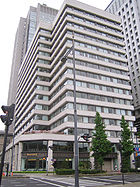
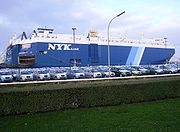
As the demand for passenger ships dwindled in the 1960s, NYK expanded its cargo operation, running Japan's first container ship
Container ship
Container ships are cargo ships that carry all of their load in truck-size intermodal containers, in a technique called containerization. They form a common means of commercial intermodal freight transport.-History:...
Hakone Maru on a route to California
California
California is a state located on the West Coast of the United States. It is by far the most populous U.S. state, and the third-largest by land area...
in 1968 and soon establishing container ship routes to many other ports. NYK became a partner in Nippon Cargo Airlines
Nippon Cargo Airlines
, or NCA, is a cargo airline based in the Onarimon Yusen Building in Minato, Tokyo, Japan. It operates scheduled cargo services in Asia and to Europe and the North America. Its main base is Narita International Airport outside Tokyo.- History :...
in 1978, and in 1985, added United States
United States
The United States of America is a federal constitutional republic comprising fifty states and a federal district...
container train service in cooperation with Southern Pacific
Southern Pacific Railroad
The Southern Pacific Transportation Company , earlier Southern Pacific Railroad and Southern Pacific Company, and usually simply called the Southern Pacific or Espee, was an American railroad....
.
NYK revived its passenger ship business in 1989 with cruise ship
Cruise ship
A cruise ship or cruise liner is a passenger ship used for pleasure voyages, where the voyage itself and the ship's amenities are part of the experience, as well as the different destinations along the way...
s operated by its newly-formed subsidiary Crystal Cruises
Crystal Cruises
Crystal Cruise Lines, most commonly seen as Crystal Cruises, is a Japanese luxury cruise line founded in 1988 and notable for its two medium-sized, high-end ships, Crystal Symphony and Crystal Serenity, which each hold about 1,000 guests. The line is a wholly owned subsidiary of the large Japanese...
.
In 1990 NYK restarted operating passengers under its own brand when Asuka entered service on the Japanese cruise market. In 2006 Asuka was replaced by the much larger , formerly Crystal Cruises' Crystal Harmony.
NYK is the tenth largest container
Containerization
Containerization is a system of freight transport based on a range of steel intermodal containers...
transportation and shipping company in the world.
At the end of March 2008, the NYK Group was operating about 776 major ocean vessels, as well as fleets of planes, trains, and trucks. The company's shipping fleet includes around 155 containerships, 286 bulk carriers, 55 woodchip carriers, 113 car carriers, 21 reefer carriers, 78 tankers, 30 LNG carriers, and three cruise ships. NYK's revenue in fiscal 2007 was about $26 billion, and as a group NYK employs about 55,000 people worldwide. The company has offices in 240 locations in 27 countries, warehouses on nearly every continent, and harbor operations in Asia, North America, and Europe. NYK is based in Tokyo and has regional headquarters in London, New York, Singapore, Hong Kong, Shanghai, Sydney, and São Paulo. However the company has been badly affected by the global recession.(see Japan`s Big 3 see red)
Selected ships in post-war fleet
The modern NYK fleet encompasses a variety of ship names. Some names comprise series, as in those ships named after flowers, stars, star constellations, and provinces of pre-MeijiMeiji period
The , also known as the Meiji era, is a Japanese era which extended from September 1868 through July 1912. This period represents the first half of the Empire of Japan.- Meiji Restoration and the emperor :...
of Japan.
Flowers
ACX Cherry (1994).
ACX Hibiscus (1997).
ACX Jasmine (1996).
ACX Lily (1990).
ACX Magnolia (1998).
ACX Marguerite (1997).
ACX Salvia (1997).
Stars
NYK Altair (2010).
NYK Antares (1997).
NYK Canopus (1998).
NYK Deneb (2007).
NYK Rigel (2009).
NYK Sirius (1998).
NYK Vega
NYK Vega
NYK Vega is a container ship, one of the largest in the world, operated by Nippon Yusen Ship Management. The vessel has a capacity of 8,600 containers in company calculations and 9,012 TEU in IMO calculations...
(2006).
Constellations
Auriga Leader
Auriga Leader
Auriga Leader is a car carrier owned by Nippon Yusen used for shipping Toyota cars from Japan to USA. It is the first ship in the world to be partially propelled by solar power.- Experimental :...
(2008).
Andromeda Leader (2007).
Apollon Leader (2007).
Cepheus Leader .
NYK Leo (2002).
NYK Orion (2008).
NYK Pegasus (2003).
NYK Phoenix (2003).
NYK Virgo (2007).
Provinces
Iga Maru (1996).
Izu Maru (1997).
Izumo Maru (1997).
Kaga Maru (1988).
Sanuki Maru (1997).
Settsu Maru (1997).
Shima Maru (1997).
Miscellaneous
Asama Maru (1954).
Astoria Maru (1952).
Galaxy Leader (2002).
Hakone Maru (1968).
Hikawa Maru (1974).
Zeus Leader (2009).
See also
- John WilsonJohn Wilson (Captain)John Wilson was the Anglicized name of Captain Frederick Walgren, a Swedish sailor and o-yatoi gaikokujin who was active in the development of British-Japanese ties in the late 19th century....
- New CarissaNew CarissaThe M/V New Carissa was a freighter that ran aground on a beach near Coos Bay, Oregon, United States, during a storm in February 1999, and subsequently broke apart. An attempt to tow the bow section of the ship out to sea failed when the tow line broke, and the bow was grounded again. Eventually,...
- Asama Maru class ocean liner
- Hikawa Maru class ocean linerHikawa Maru class ocean linerThe was a class of ocean liners of Japan, serving during 1930s, and after World War II.-Background:* In 1925, Swedish American Line was constructed the excellent passenger MS Kungsholm...
- Terukuni Maru class ocean linerTerukuni Maru class ocean linerThe was a class of ocean liners of Japan, serving during the 1930s, and after World War II.-Background:* In 1925, Swedish American Line was constructed the excellent passenger MS Kungsholm...
External links
- Company website (in English)
- Logistics Division of NYK Group (in English)
- Regional website for NYK Group in Europe (in English)
- group official website of history
Further reading
- Richard Cook and Marcus Oleniuk (April 2007). Around the World in 40 Feet, Two Hundred Days in the Life of a 40 ft NYK Shipping Container. WordAsia Publishing. ISBN 978-988-97392-3-2

